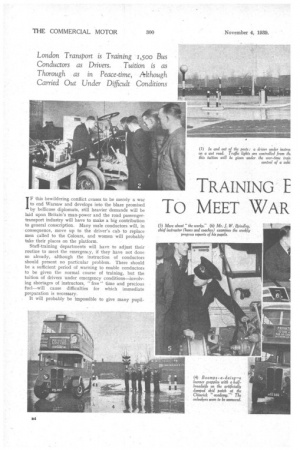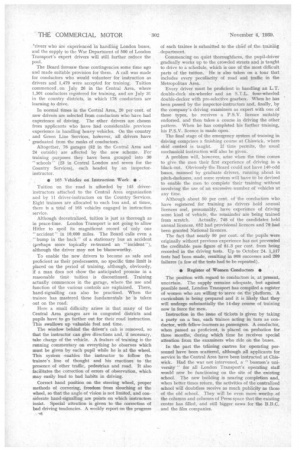TRAINING E
Page 30

Page 31

Page 32

If you've noticed an error in this article please click here to report it so we can fix it.
PERSONNEL TO MEET WAR VIE CONDITIONS
IF this bewildering conflict ceases to be merely a war to end Warsaw and develops into the blaze promised by bellicose diplomats, still heavier demands will be laid upon Britain's man-power and the road passengertransport industry will have to make a big contribution to general conscription. Many male conductors will, in consequence, move up to the driver's cab to replace men called to the Colours, and women will probably take their places on the platform.
Staff-training departments will have to adjust their routine to meet the emergency, if they have not done so already, although the instruction of conductors should present no particular problem. There should be a sufficient period of warning to enable conductors to be given the normal course of training, but the tuition of drivers under emergency conditions—involving shortages of instructors, "free" time and precious fuel—will cause difficulties for which immediate preparation is necessary.
It will probably be impossible to give many pupil drivers a concentrated course of training. Conductors will, in most cases, have to be taught to drive outside duty hours and instruction will, consequently, have to be spread over a longer period than normal. For this reason an early start with the training of suitable conductors as drivers is essential, so that operators shall not be caught napping should the ranks of drivers suddenly be depleted.
Passenger-transport operating conditions in London are, perhaps, peculiar, but the measures adopted by London Transport to ensure an adequate supply of expert drivers should serve as a guide to provincial undertakings.
Fuel rationing and evacuation have, naturally, combined to reduce London bus services, but most of the displaced men who have not joined the fighting forces have been absorbed in A.R.P. work and are standing by to man the hundreds of Green Line coaches that have been converted into ambulances. The result is that there is not available a large number of surplus
.'rivers-who are experienced in 'handling London buses, and the supply to the War Department of 500 of London Transport's expert drivers will still further reduce the pool.
The Board foresaw these contingencies some time ago and made suitable provision for them. A call was made for conductors who would volunteer for instruction as drivers and 1,479 were accepted for training. Tuition commenced on July 26 in the Central Area, where 1,301 conductors registered for training, and on July 31 in the country districts, in which 178 conductors are learning to drive.
In normal times in the Central Area, 20 per cent. of new drivers are selected from conductors who have had experience of driving. The other drivers are chosen from applicants who have had considerable previous experience in handling heavy vehicles. On the country and Green Line Services, however, all drivers have graduated from the ranks of conductors.
Altogether, 76 garages (52 in the Central Area and 24 outside) are affected by the new scheme. For training .purposes they have been grouped into 30 " schools" (23 in Central London and seven for the Country Services), each headed by an inspectorinstructor.
• 165 Vehides od Instruction Work • .
Tuition on the road is afforded by 145 driverinstructors attached to the Central Area organization and by 11 driver-instructors on the Country Services. Eight trainees are allocated to each bus and, at times, there is a total of 165 vehicles engaged in instruction service.
Although decentralized, tuition is just as thorough as in peace-time. London Transport is not going to allow Hitler to spoil its magnificent record of only one " accident " in 10,000 miles. The Board calls even a " bump in the back" of a stationary bus an accident (perhaps more topically re-termed an " incident "), although the driver may not be blameworthy.
To enable the new drivers to become as safe and proficient as their predecessors, no specific time limit is placed on the period of training, although, obviously, if a man does not show the anticipated promise in a reasonable time tuition is discontinued. Training actually commences in the garage, where the use and function of the various controls are explained. There, hand-signalling can also be practised. When the trainee has mastered these fundamentals he is taken out on the road.
Here a small difficulty arises in that many of the Central Area garages are in congested districts and pupils have to go farther out for their road instruction, This swallows up valuable fuel and time.
The window behind the driver's cab is removed, so that the instructor can give directions and, if necessary, take charge of the vehicle. A feature of training is the running commentary on everything he observes which must be given by each pupil while he is at the wheel. This system •enables the instructor to follow the trainee's line of thought and his reactions to the presence of other traffic, pedestrian and road. It also facilitates the correction of errors of observation, which may easily lead to bad habits in driving.
Correct hand position on the steering wheel, proper methods of cornering, freedom from slouching at the wheel, so that the angle of vision is not limited, and considerate hand-signalling are points on which instructors insist. Special attention is given to the correction of bad driving tendencies. A weekly report on the progress of each trainee is submitted to the chie. f of the, training
department. • Commencing on quiet thoroughfares, the pupil-driver gradually works up to the crowded streets and is taught
to drive to a schedule, which is one of the most difficult parts of the tuition. He is also taken on a tour that includes every peculiarity of road and traffic in the Metropolitan Area.
Every driver must be proficient in handling an L.T.
double-deck six-wheeler and an S.T.L. four-wheeled double-decker with pre-selective gearbox. When he has been passed by the inspector-instructors and, finally, by the company's driving examiners as expert with one of these types, he receives a P.S.V. licence suitably endorsed, and then takes a course in driving the other pattern. When he has completed his further training, his P.S.V. licence is made open.
The final stage of the emergency system of training in driving comprises a finishing course at Chiswick, where skid control is taught. If time perMits, the usual mechanical instruction will also be given.
A problem will, however, arise when the time comes to give the men their first experience of driving in a.
black-out. Obviously the Board could not have 140-odd buses, manned by graduate drivers, running about in pitch-darkness, and some system will have to be devised
to enable the men to complete their •training without involving the use of an excessive number of vehicles at any time.
Although about 50 per cent. of the conductors who have registered for training as drivers hold annual licences and, presumably, have experience of driving some kind of vehicle, the remainder are being trained
from scratch. Actually, 748 of the candidates held annual licences, 652 had provisional licences and 79 had been granted National licences.
The fact that nearly 50 per cent. of the pupils were originally without previous experience has not prevented
the creditable pass figure of 81.3 per cent. from being recorded in the driving tests. Up to October 24, 1,117 tests had been made, resulting in 908 successes and 209 failures (a few of the tests had to be repeated).
• Register of Women Conductors •
The position with regard to conductors is, at present, uncertain. The supply remains adequate, but against possible need, London Transport has compiled a register of women who are willing to 'serve on the platform. A curriculum is being prepared and it is likely that they will undergo substantially the 14-day course of training now in force for men.
Instruction in the issue of tickets is given by taking a party on a bus, each trainee acting in turn as conductor, with fellow-learners as passengers. A conductor, when passed as proficient, is placed on probation for three months, during which time he receives special attention from the examiners who ride on the buses.
In the past the tr'aining mitres for operating personnel have been scattered, although ail applicants for service in the Central Area have been instructed at Chiswick. Had the war not intervened, a. "busmen's university" for all London Transport's operating staff would now be functioning on the site of the existing school. The new building is nearing completion and, when better times return, the activities of the centralized school will doubtless receive as much publicity as those of the old school. They will be even more worthy of the columns and columns of Press space that the existing centre has filled, and still bigger news for the B.B.C. and the film companies.




























































